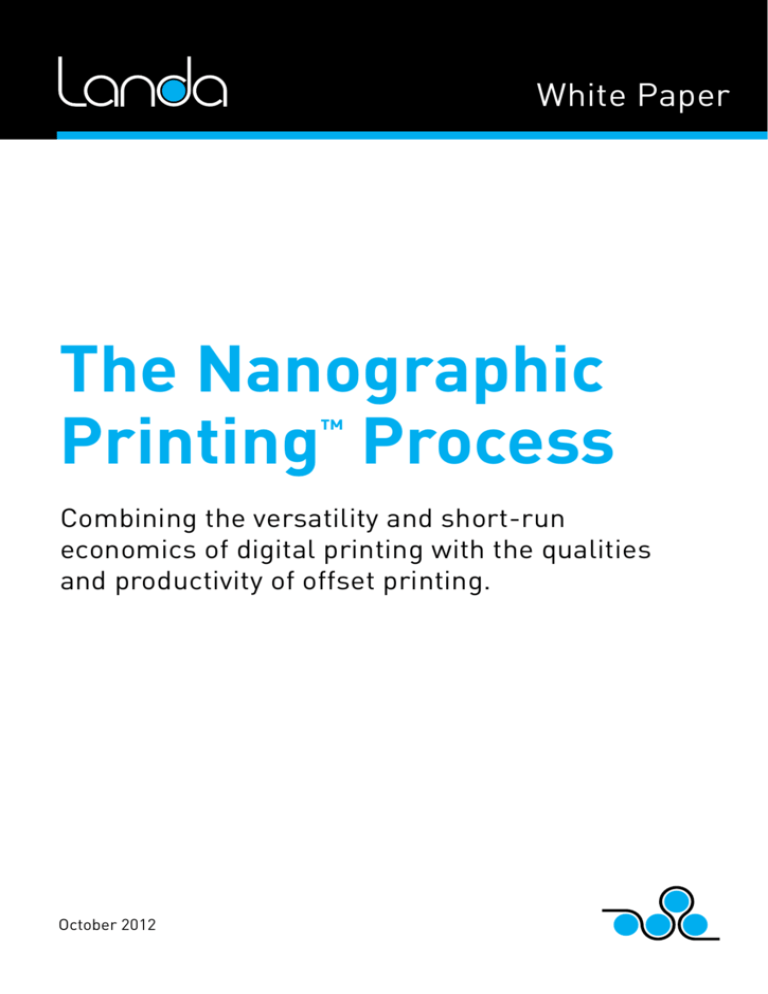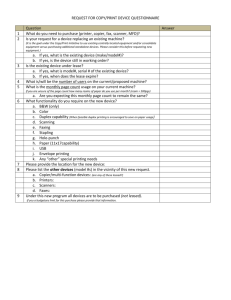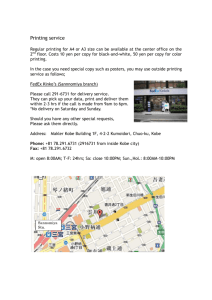
White Paper
The Nanographic
Printing Process
™
Combining the versatility and short-run
economics of digital printing with the qualities
and productivity of offset printing.
October 2012
Executive summary
In May 2012, Benny Landa – inventor of the Indigo Digital Press – brought news of a breakthrough that
may greatly advance print technology and its related economics. Since then, the blogosphere already has
articles suggesting that this could be the biggest change in printing since Gutenberg invented the printing
press.
Nanographic Printing™ technology, also called Nanography, differs from other printing technologies
because it uses an innovative system and printing process that employs Landa NanoInk™, a proprietary
water-based ink with nano-pigment particles that measure tens of nanometres in size.
Unlike lithography, Nanographic Printing™ technology harnesses the advantages of digital printing,
including shorter turnaround times, reduced waste, the ability to print runs as short as one copy, as well
as variable data printing. At the same time, it also offers offset qualities.
Whereas inkjet printing jets transfer the image directly onto the substrate, Nanography™ first ejects the
Landa NanoInk dispersions onto a unique heated blanket, and only then is the ink transferred from the
blanket to the substrate in the form of an ultra-thin film. This document demonstrates how Nanography
achieves the combined versatility and short-run economics of digital printing with the qualities and
productivity of offset printing.
Introduction
In the printing market, 98% of the pages are not printed using digital technology, but use technology that
is essentially 500 years old. One of the main reasons is because when modern digital printing processes
apply ink directly to paper, the wet ink penetrates the paper and many of the pigment particles end up
beneath the surface becoming inefficient absorbers of light.
Additionally, when multiple colours are printed on top of each other, there is a limit to the amount of
wet ink that can be applied to the paper. This maximum threshold is referred to as either TIC (Total Ink
Coverage) or TAC (Total Area Coverage). Any ink applied beyond such limit does not attach itself to the
previous layers and more significantly, the wet ink is not able to dry properly on the substrate. This can
lead to ink smudging of the subsequent printed sheets.
This is true for all printing processes, from offset to inkjet. In the case of inkjet printing, there is so much
water in the ink that the paper becomes completely saturated, swollen, deformed and cockled. The paper
must then be heated and the water evaporated from the paper. This limits aqueous inks to low area
coverage applications, such as books and transpromotional materials – and makes it unsuitable for high
area coverage applications such as commercial printing, packaging or for specific applications in the
publishing sector, such as magazines or colourful books.
The Nanographic PrintingTM Process
1
The Nanographic difference
The Landa Nanographic PrintingTM process is innovative in that it utilises the nano-sized pigments to
absorb much more light than other pigments, and thus permits images with ultra-sharp dots of extremely
high uniformity, high gloss fidelity and a broad CMYK colour gamut – covering at least 15% more Pantone
colours than offset printing.
Fig 1. Light absorbance comparison: conventional ink vs. Landa NanoInk™ formulations.
Many of the advantages of the Landa Nanographic Printing process are achieved by eliminating the
absorption of the liquid ink carrier by the substrate.
In addition, the ultra-small Landa NanoInk pigments – and their ability to form a very thin layer of ink –
allow digital printing at very high speeds; the ability to print on ordinary untreated paper stocks, whether
coated or uncoated; and on practically any plastic packaging film or label stock; and the production of
abrasion- and scratch-resistant images.
Landa NanoInk™
Many materials, when reduced to nano particle size, acquire unexpected properties. Some particles become
super-hard, able to protect surfaces from abrasion; some become super-absorbent in the blood stream,
enabling unique drug delivery systems. In the course of a decade of research, Landa observed that ink
pigments, when reduced to nanometric scale, become unusually powerful colourants (Fig. 1). On the basis
of this discovery, NanoInk colourants are used at the core of the Landa Nanographic Printing™ process.
Landa NanoInk™ contains ultra-small pigment particles in the tens of nanometres in size. In comparison,
good quality offset inks have a particle size of approximately 500 nm — at least ten times larger. NanoInk
is water-based and ecofriendly.
2
The Nanographic Printing process
The Nanographic Printing process begins with the jetting of billions of droplets. However the droplets
are not ejected directly onto the substrate as they are in the traditional inkjet process. Instead, they are
ejected onto a blanket from ink ejectors that are mounted on print bars, onto a blanket positioned 1-2
mm away.
Each print bar prints a specific colour. Landa Nanographic Printing Presses are equipped with eight
print bars (Fig. 2) and are therefore capable of printing up to eight different colours simultaneously.
Furthermore, the eight print bars can be employed for CMYK, spot or speciality colours such as white.
The eight print bar configuration allows having two colour bars for each colour, which in combination with
doubling the paper handling system speed, allows doubling the productivity while maintaining the print
quality.
The ink drop ejection onto the blanket is precisely timed to obtain very high accuracy between print
separations and achieve high colour plane registration.
Fig 2. A schematic perspective view of a Landa Nanographic Printing™ Press.
The Nanographic PrintingTM Process
3
As each ink droplet lands on the heated blanket, it spreads and very quickly loses its water, becoming
thinner as it does so. When all of its water has been evaporated, the ink becomes an ultra-thin, dry
polymeric film on the blanket (Fig. 3).
Fig 3. Ink droplets interacting with the blanket following impact and carrier evaporation (illustration).
When pressed into contact with the printing substrate upon transfer, this thin 500 nm layer of ink
instantaneously bonds tenaciously to the substrate without penetrating it (Fig. 4). The formed images are
tough, abrasion resistant, do not need post-drying and leave no residual ink on the blanket.
4
So two-sided printing becomes simple – and the printed output can immediately be processed, even on
the most aggressive finishing equipment, right off the press.
Fig 4. Landa NanoInkTM dot vs. Inkjet dot on paper (illustration).
The transfer blanket
The design of the optimum blanket and blanket conveyor system embodies some critical considerations
to ensure perfect image, including the full image transfer to the paper, the prevention of any ink residuals,
and smooth and stable blanket motion.
The design enables a suitable balance between receiving the Landa NanoInk drops, permitting them
to create a perfect image, and concurrently allows the transfer of the ink film to the various substrate
types without leaving a trace on the blanket. This ensures that the full image is transferred without any
distortions and the blanket remains completely clean – ready to receive the next image ejection.
The Nanographic PrintingTM Process
5
The difference in the dots
Inkjet-printed dots are typically characterised by poorly defined edges. This effect is due to the capillarity
of the aqueous ink that causes it to be absorbed and wicked along the paper fibers. Offset printed dots are
generally sharper than inkjet, but also suffer from edge raggedness due to ink capillarity.
As mentioned, the Landa NanoInk droplets form a dry ink film when applied to the paper or other substrates
– and unlike directly applied wet inks, there is no penetration into the paper fibers. So the Landa NanoInk
film does not wick along the paper fibers. Instead, it conforms to the surface roughness, right down to
the topography of individual paper fibers, literally laminating the paper surface and therefore permitting
precise and extremely efficient low ink laydown. This accounts for the ability of the Nanographic Printing
technology to match the gloss of the paper and to produce dots with super-sharp edges and high optical
uniformity. As a result, dots obtained using the Landa Nanographic Printing process are exceptionally
round (Fig. 5).
Landa NanoInk Dot on Uncoated Paper
Offset Dot on Uncoated Paper
Fig. 5. Dot shape comparison on uncoated paper: Landa NanoInkTM vs. Offset.
6
Extended colour gamut
Colour Gamut Comparison
The Landa Nanographic Printing process breaks
through yet another barrier. Because the Landa
NanoInk pigments are extremely small, the light
dynamic range achieved by the Landa NanoInk
formulation in the Nanographic Printing process is
wider than any other printing processes and covers
more Pantone colors than offset printing. This
translates into bigger effective gray levels. (Fig. 6).
Additionally, Nanography and Landa NanoInk
create printed solid areas with lightness depth
(density) values incomparable to any other printing
process technology.
Fig. 6. Colour gamut comparison chart.
High gloss uniformity
Another amazing outcome of the very thin effective layer created in the Nanographic Printing process
is the fact that the images have extremely high gloss fidelity with the substrate printed on. That means
glossy images on glossy stock, and matte images on matte stock – all while maintaining the highest
image qualities such as optical density, dot shape and others.
In contrast, images printed on a dry toner electrophotographic press display the same gloss regardless of
the gloss level of the printed media. The gloss differences between the printed area and the background
are irritating to the human eye and are perceived as low-quality printing.
Media friendly
The ultra-thin Nanographic Printing ink film has an extraordinary ability to bond to all paper and plastic
printing substrates. Due to the above described transfer technique, Landa NanoInk images can easily be
applied to a wide range of sheet or web substrates, including untreated paper stock – coated or uncoated,
plastic, newsprint, film and more. As the ink film contains no water or other liquids, Nanography
preserves the substrate from both water damage and deformation.
With Nanographic Printing technology, the substrate remains dry, and since very low heat is applied to
the paper surface, it maintains the substrate’s pure qualities.
The Nanographic PrintingTM Process
7
The Nanographic Printing economic advantage
The Nanographic Printing process offers the capacity to yield the lowest cost-per-page of all the digital
printing technologies. This is due to a variety of aspects relating to its underlying technology. They include:
● The ink carrier – Landa NanoInk solutions are based on water which is a less costly ink carrier than any
solvent or UV based inks.
● The amount of ink used – The Landa Nanographic Printing process creates a film of about 500 nm that
is approximately half the thickness of an offset printed image and uses less ink for the same image.
● Energy consumption – The Nanographic Printing process is energy efficient and heating is used mainly
to evaporate the limited amount of water in the ink rather than to dry out water-soaked paper.
● Substrate cost – Printing on any substrate enables you to print on low-cost, off-the-shelf uncoated
paper rather than expensive coated paper or specially designed paper.
● Production logistics – Landa NanoInk is manufactured and shipped as a concentrated solution that
reduces packaging, shipment and storage costs.
The combination of Landa NanoInk and the Nanographic Printing process, allows digital production at
up to 13,000 B1 sheets per hour for sheetfed and 200 metres per minute for webfed presses. This is
an improvement of nearly 100% over other digital printing processes that will significantly boost the
productivity of a company’s digital business.
Conclusion
The Nanographic Printing™ process is a new technology and opens up a new category of printing. It
uniquely combines a special printing process with water-based Landa NanoInk™ colourants and
a specially designed transfer blanket.
With the productivity, substrate range, and print qualities of offset and a break-even point of around 5000
sheets, Nanography™ is the first digital printing process that can compete in the mainstream market.
As printing shifts from offset to digital, printers will not be able to sustain growth into the future with
offset alone. Nanography addresses the principal obstacles faced by digital technology today, including
speed, quality and cost and can fundamentally change the print industry.
8
About Landa
The Landa Group was founded by Benny Landa ten years ago following the acquisition by Hewlett-Packard
Company of Indigo, which Landa had founded 25 years earlier. The Landa Group has four operating units:
Landa Digital Printing, which develops Nanographic PrintingTM systems for the commercial, packaging
and publishing markets; Landa Labs, which develops alternative energy technology as well as nanomaterials for applications ranging from pigments and drug delivery to hair colourants and composite
materials; Landa Ventures, which invests in promising technology companies in fields related to
nanotechnology, imaging, printing and energy; and Landa Fund, a philanthropic entity dedicated to the
narrowing of socioeconomic gaps in society by enabling youth of “privileged minds and underprivileged
means” to achieve higher education. To date, the Landa Fund has enabled thousands of underprivileged
youth to acquire university degrees.
Benny Landa continues to add to the portfolio of over 700 patents granted to him worldwide that provide
the companies which he founded with a solid intellectual property base.
The explanations provided in this document concern hypothetical reasons underlying certain observations and are simplifications of complex
phenomena involving numerous processes and contributory agents. The purpose of this document is not to address the nature and role of all such
intricate factors, but to provide a simple theory to ease the comprehension of this multifaceted technology. This document may also contain forwardlooking statements, targets and information that involve risks, uncertainties and assumptions, and such statements should be viewed accordingly
with caution.
www.landanano.com
www.landanano.com/social
© 2012 Landa Corporation Ltd. All rights reserved. Landa, Nanographic Printing, Landa Nanographic Printing, Nanography, Landa Nanography,
NanoInk, Landa NanoInk and the related logos and slogans are trademarks of Landa Corporation Ltd. All other trademarks are the property of their
respective owners. This information is subject to change without notice. This news release may contain forward-looking statements that involve risks,
uncertainties and assumptions and such statements should be viewed with according caution. Landa Corporation Ltd. shall under no circumstance be
liable for technical or editorial omissions or errors.
WP.101.2012.10.04.UK






